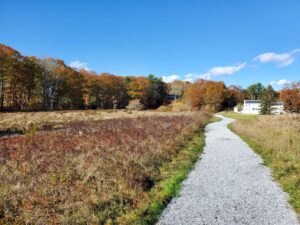November 2: The Remarkable Red Oak

Red Oak Leaf
Late fall has arrived, the time of year when I notice just how many red oak trees we have in our region. They are very eye catching right now, with their russet orange leaves still clinging on, giving us some color in a time when most other tree species display bare branches. Red oaks are prominent in our area, lending themselves to location names such as Oak Street and Oak Point in Boothbay Harbor. Boothbay Region Land Trust’s headquarters is located at Oak Point Farm, an appropriate name as the preserve is covered in red oak trees.

Young Red Oak Tree
Red oak is the most common oak species in Maine, occurring statewide but most abundant in the southern part of the state, including our region. These trees grow about 100 feet tall and average a 40 feet diameter, sometimes reaching a six-foot diameter when growing in a field. The fields at BRLT’s Oak Point Farm have some very large diameter red oaks growing in them. The bark of these trees is a distinguishing feature, with raised ridges and low stripes where the red inner bark shows through, giving the tree its name. The leaves are five to ten inches long and four to six inches wide, with distinguishable pointed lobes.
Perhaps the most recognizable nut in the forest, the acorns produced by the red oak tree, are a valuable food source for wildlife. Acorns have been used by humans to make a flour, but due to their tannic content they can be quite bitter and require leaching with cold water. These acorns take two years to fully grow, dropping in their second fall. The amount of acorns that fall from a tree each year is called its mast, and scientists have discovered that red oak mast production usually peaks every two to three years. These times are referred to as “mast years” and often precede a population boom in squirrels and other acorn eating animals.

Red Oaks Line the Field at BRLT’s Oak Point Farm
In addition to a food source, the red oak also provides wood for a variety of uses. It is a popular choice in furniture building, flooring, firewood, shipbuilding, and is used as runners on lobster traps. It is a tree worth noting and growing for the beauty it offers us and the value it provides to wildlife. Pretty soon the beautiful russet brown leaves will drop to the forest floor and the trees will meld into the landscape. I will be waiting for the days in spring when the red oaks become colorful again, when their buds unfurl silky pink leaves that hint of warmer days ahead.




